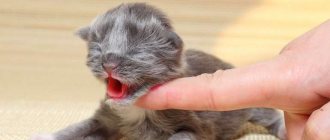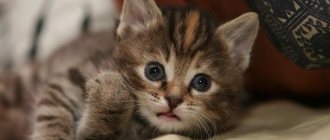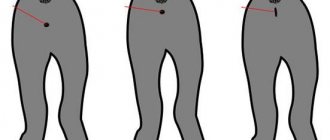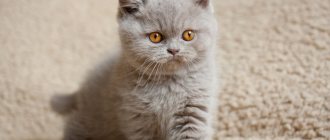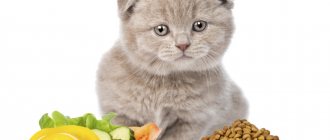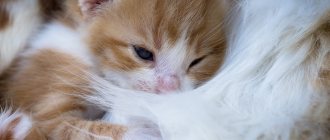Sometimes it happens that after the birth of kittens, a cat is unable to feed them breast milk on her own.
A milk replacer for kittens will help solve this problem. In this article we will tell you about the features of cat milk, help you choose a quality substitute, and also talk about its dosage and use. The article will also describe several recipes with which you can prepare replacement mixtures at home. This is useful if you do not have the opportunity to purchase ready-made formula in a store or order it online, and the kittens need to be fed urgently.
© shutterstock
Dishes for feeding kittens
You can feed kittens from bottles and syringes purchased at the pharmacy. Often, an ordinary disposable syringe without a needle is used for this purpose. The syringe must be replaced with a new one throughout the entire feeding period. Its lower end is sometimes rounded, treated with thin sandpaper or a file. Even in cases where the kitten initially does not immediately like this method of feeding, he will gradually get used to it and even begin to suck out the contents of the syringe.
A homemade device in the form of a bottle of used drops and a pipette is also suitable for feeding kittens. A bottle of eye drops, for example, chloramphenicol drops, is ideal. It resembles a baby bottle, and the top part is adapted for a nipple made from the rubber part of a pipette. Before use, all items are washed well and must be sterilized. Abandoned kittens have very weak immunity, so bottles and nipples must be sterilized and the syringe replaced with a new one.
What will you need for self-feeding?
To feed a small newborn kitten, you should purchase special equipment:
- A pacifier, but definitely not a baby one . You will need a special one, which can be purchased at a pet store or veterinary pharmacy. But the baby is fed without a pacifier; it will be needed a little later.
- Pipette . This is the best option for feeding the animal. Its convenience is that food can be served in doses and the volume can be clearly calculated. However, the pipette should be used carefully, since air entering it can cause severe bloating in the baby.
- Spoon - theoretically, a kitten can be taught to eat mixture from a spoon, but this method of feeding contributes to the suppression of sucking reflexes.
- Syringe – used without a tip (needle). This device is considered the most convenient and easy to use. The syringe's nose resembles a cat's nipple and helps develop conditioned reflexes.
Bottles. Pet stores sell special feeding bottles. However, they all have standard universal sizes, so they are not suitable for all breeds of kittens. Owners will need to select an individual size:
- When you turn the bottle over, milk flows out. This indicates that the hole diameter is too large. Intensely leaking milk threatens the kitten with choking.
- The milk comes out of the container only after pressing on it - the hole has an insufficient diameter, so the milk comes out with difficulty, because of this the kitten will not be able to suck it. Such inconvenience for the animal will lead to it refusing to eat.
- The ideal hole size is that the milk drips slowly when you lightly press the sides of the bottle.
It is important to immediately select the correct hole diameter for the kitten.
The animal will quickly get used to a certain type of nipple, and replacing it can lead to a complete refusal to eat from the bottle. It is difficult for a person to replace a mother cat for a newborn kitten. But if you put maximum effort and attention into the process, it will turn out very well.
Special feeding tube
This device is used if it is not possible to awaken the baby’s sucking reflex, accordingly, other methods of feeding are impossible, or the animal is too weak to suck on its own.
Using a special tube is the cleanest and most hygienic method of feeding kittens. But using this device requires a certain skill and extreme care. Disadvantages of using a tube:
- There is no way to control the amount of food, which is why the kitten receives too much of it (extremely bad for digestion) or, conversely, not enough.
- If the baby has a well-developed sucking reflex, but cannot satisfy it due to the lack of a pacifier or syringe, he begins to “suck” the fur of another kitten or his own. He does this too intensely, which can lead to serious skin diseases.
Algorithm for using the handset:
- Open your pet's jaw by pressing on it with your fingers. Before inserting the tube into the esophagus, it must be lubricated with a special product, for example, KY jelly.
- Hold the kitten's head straight while pushing the tube down the esophagus. You need to slide across the sky, moving the device along the back wall of the esophagus.
- The tube should be advanced until the mark on the hose is equal to the level of the nose - it has reached the esophagus.
- Connect a syringe with the nutritional mixture to the tube. It is recommended to press the piston slowly and carefully.
How to make a mark? The distance from the animal's nose to the last rib is measured. The mark is needed in order to insert the tube correctly, directly into the stomach.
Risk of improper use of the tube. You cannot use the tube without certain knowledge and skills. When deciding to feed a kitten with a special device, you must consult with a veterinarian who will demonstrate the correct use of this device.
Incorrect technique for using the tube carries the risk of it getting into the respiratory tract. If the kitten squeaks while feeding, it means that the tube has entered the stomach without touching the respiratory organs. Given the difficulty of tube feeding kittens, this method is mostly used by breeders.
How to take care of a kitten
Babysitting a newborn without a mother cat is not an easy task, but it can be done.
You have to fulfill several conditions to successfully raise a kitten at home:
- Find a mixture similar to cat milk;
- Observe the temperature regime (food temperature - 36-38 degrees);
- Keep the cat warm, from 25 to 30 ° C and wipe it after feeding;
- Follow the kitten's body signals. Diarrhea, constipation or nausea in the patient indicate that the mixture is not suitable.
There are many cases when a cat dies during childbirth. It happens that she refuses offspring. Nervous cats sometimes show no interest in their offspring and are apathetic or aggressive. Getting a mustachioed shrew to feed newborns is almost impossible, and even dangerous for babies.
If a mother cat does not have the strength or patience to feed her babies, you can try to find a replacement for her among the neighbors. Another good news: a miniature dog can also cope with the role of nurse. Maternal instinct will work in such a way that someone else's animal will begin to take care of the little cat. Even a cat is suitable for care, because in addition to food, the kitten will have to be provided with warmth and hygiene. Before entrusting a four-legged orphan to the “teacher”, make sure that she has no infectious diseases. You should not expose a newborn to unvaccinated cats, and it is also important to carry out prevention against worms.
Let's assume we managed to find a nanny. But it may turn out that she feeds her foster child poorly and gets irritated at the sight of a stranger. Perhaps a nursing cat does not have enough experience. In this case, it will be better for you to take the baby out of harm's way. Every veterinary pharmacy is replete with mixtures for crumbs.
Temperature and dose of milk
Depending on its size, the kitten is given approximately 2.5 milliliters of the mixture, adding half a milliliter evenly after two feedings. After three days, the baby is able to drink up to 10 milliliters of milk. The temperature of the mixture should not exceed 38-39°C. That is, the mixture should not be hot, nor should it be cold. You can check whether the formula is suitable for feeding a kitten by dropping it on your wrist. The warm mixture does not burn.
Often, when feeding, they adhere to the following regimen, depending on age: - 1 week - approximately 30 milliliters per 100 grams of weight; - at 2 weeks 35 milliliters per 100 grams of weight is given; - at 3 weeks the norm is 40 milliliters per 100 grams of weight; - from 4 weeks - ranging from 48 to 53 milliliters per 100 grams of weight.
In what cases is milk feeding necessary?
Stories of developments can be very different and unforeseen, for example:
- the cat had a caesarean section, the first days after the operation she will not be able to feed her babies, and then everything depends on the restoration of her lactation;
- a rare exception when, for some unknown reason, a young mother refused to feed her babies;
- newborns do not have enough mother's milk, since there are more than eight of them in the litter;
- found and picked up a newborn animal;
- The fluffies have grown to 3 weeks and it’s time to introduce complementary foods.
The best and safest food for an abandoned, newborn baby is natural feeding by a cat nurse. But not all babies left without breast milk can find a lactating female. Therefore, experienced cat owners and veterinarians recommend feeding kittens with adapted formulas for children.
How often are newborn kittens fed and how is the serving size determined?
In order for tiny babies to emerge, they will have to be fed every 2 hours, including at night. Two-week-old kittens can be fed every 3 hours during the day and once at night. Feeding three-week-old cats involves feeding them 4 times a day during the day; they are not touched at night. After eating, the kittens immediately fall asleep, and when hungry, they begin to squeak loudly and crawl around the box, poking their noses into the walls.
For the first five days after birth, kittens should eat 30 ml of the prepared mixture per 100 g of weight per day. Then the amount of food is gradually increased so that the daily norm is 38 ml/100 g. From the 15th day, every day the baby is given 45 ml/100 g of weight. This diet is maintained for the next 9 days, and then, for a month, the daily dose is 55 ml.
With a properly selected diet, the cat should regularly gain weight. If at the time of birth the baby weighs 90 g, then in the first week of life he should add 20 g, up to 110 g, and a week later - up to 190–200 g. In the third week, the baby’s weight should be at least 270 g. When does the kitten weigh a little less than 400 g, they begin to gradually introduce complementary foods.
Procedure
Having prepared the mixture, do not forget that the feeding procedure itself must be properly prepared. When feeding a newly born kitten, it is carefully picked up. Lightly placing a purchased or home-made pacifier into the baby's mouth, support it at an incline of 45. If the baby suddenly coughs, you should turn him head down so that he does not choke.
© shutterstock
Experienced cat owners advise that while feeding, gently and lightly stroke the kitten on the head and, if possible, imitate the calm purr of a nursing cat. According to many breeders, such actions have a very beneficial effect on babies. When a kitten is left without its mother, a cat, it is more sensitive to affection and living warmth.
A well-fed kitten can be identified by the milk remaining on its face and round tummy. Milk “gurgles” coming from the baby’s mouth also indicate saturation. In addition, a well-fed kitten stops sucking the formula and falls asleep.
After the feeding procedure is completed, wipe the kitten’s face and any soiled parts of the baby’s body with a cloth soaked in warm water, preventing the mixture from drying on the fur. Such care is mandatory for hygiene.
Feeding kittens
In order for babies to develop normally, they need a proper diet with the obligatory presence of vitamins. To create mixtures for kittens, you should get a small measuring cup. You also need to know how much weight of a particular component a teaspoon or tablespoon can hold. This knowledge will be useful when preparing mixtures.
All kitten formula recipes include dairy products. At best, food that replaces cat milk is purchased at pharmacies and pet stores. However, this option is not always suitable for everyone. Therefore, people use self-created mixtures to feed kittens.
To create a milk formula for a kitten, goat's milk with a fat content of up to 2.5% or cow's milk - 1.5% is often used. Once every 2 days, you can add the yolk of quail eggs and 2-3 drops of syrup consisting of 1 teaspoon of water and 1 teaspoon of sugar to the milk.
When the kittens open their eyes, they should be given any meat mixture intended for human children. At first, it replaces one milk feeding. A day later another one and so on.
The meat mixture (2.5 ml) should be diluted with one teaspoon of water, stirring until it becomes liquid sour cream. Kittens are fed through a syringe or pacifier. The solution is stored in the refrigerator for 24 hours.
Reviews about caring for kittens without a cat
As far as I know, kittens cannot survive on mixtures alone. A friend feeds formula + goat's milk, another only feeds goat's milk + quail eggs, both nurse stray, weak newborn kittens from time to time. As a rule, babies die on some mixtures. Both friends have produced more than one litter of kittens from scratch, some were found simply in a box in the entrance, others in bags in a trash can. In general, they fed successfully and safely
Gia
https://www.zoovet.ru/forum/?tid=35&tem=660158
In our entrance, a cat somehow lambed and disappeared... apparently she was hit by a car... I picked up her Siamese kitten and fed her baby formula, first through a pipette and a syringe, he lay with me with a heating pad (45 degrees) when he fed his stomach on a heating pad, massage and pooped he. The navel fell off on the 7th day, and after 2 weeks the eyes began to open! A month later he was already crawling and then started running!!! I love him very much, I named him son!!! He loves me very much!!! Now he is 3 years old!!!
Oksana
https://www.baby.ru/community/view/920867/forum/post/29600157
If a cat is left without a mother, its survival is entirely dependent on the person. The animal needs warmth, hygienic care, protection from danger and, of course, constant feeding. If difficulties arise in the process (for example, the baby categorically refuses to eat or weight gain is too slow), you should contact a specialist. The veterinarian will examine the animal and tell you what specific care features the newborn requires.
for feeding a newborn kitten on small kittens newborn kittens feeding kittens newborn kittens feeding kittens finishing feeding kittens which newborn kittens newborn kittens newborn kittens without
BreedsArticleDogNoContents
How and what should newborn kittens be fed?
Feeding helpless newborn kittens is the most crucial moment in care. An undeveloped digestive system requires a serious approach to choosing formula milk. In the first days of life, the cat feeds the babies colostrum, which will ensure the development of primary immunity. Cats cannot do without it, but in a veterinary clinic they can inject a special serum subcutaneously. It is made from cat blood and contains all the necessary substances that protect babies from viruses and harmful bacteria.
Experts recommend feeding newborn babies frozen milk from another cat, but this option is not always available. You cannot feed them cow's milk, because it does not contain the necessary proteins and amino acids. With such a diet, kittens begin to get sick and quickly die. Cat milk has a unique composition; it contains a lot of taurine and fats. It can only be replaced with specially developed mixtures for cats.
Ready-made milk formulas - cat milk substitutes (brands, composition, price)
Feline formula is produced by different manufacturers. It is adapted for babies, does not cause allergies and contains all the substances necessary for a small body.
Each package contains a convenient bottle, preparation instructions and a description of the composition. The product is sold in large plastic jars weighing 200, 300 or 500 g, inside which are placed 3 bags of formula, several nipples, a bottle and a measuring cup. The most popular manufacturers of such cat food on the world market are Beaphar. The first produces the “Babycat Milk” mixture, and the second – “Kitty Milk”.
Both products have a similar composition and contain:
- protein;
- minerals;
- taurine;
- amino acids;
- vitamins;
- antioxidants;
- fats;
- fiber.
For a jar of “Kitty Milk” weighing 200 g you will have to pay from 640, 500 g – from 1300 rubles, and the “Babycat Milk” mixture (300 g) will cost the owner from 1200 rubles. There is a mixture with the addition of German maternal colostrum "Kittenmilch", its cost is from 1200 rubles for a package weighing 90 g and from 4860 for 750 g. How much cat milk substitute is needed for 21 days (after three weeks babies can be fed), depends on the recommendations on its application.
For which breeds - which substitute?
Cat milk replacers are universal not only for all cat breeds, but also for most young pets in general. For example, many owners give a mixture of the same manufacturer to both kittens, puppies, and ferrets. The main difference when feeding is the breed for which the replacement is needed. The larger the kitten, the more nutrients it needs. Of course, the dose must be increased very carefully, because the pet’s stomach is very small in the first weeks. You should also monitor the color of the feces and whether the kitten falls asleep after feeding.
Source
Kitten formula recipes
1. In a liter of boiling milk, stir 1 teaspoon of bone meal, 200 milliliters of condensed milk without sugar and 100 milliliters of water. The resulting mixture is filtered and cooled.
2. Mix 2 egg yolks, a glass of milk, 1 teaspoon of vegetable oil, 1 drop of Tertravit or Trivit vitamins.
3. Use 0.5 teaspoon of unrefined vegetable oil as an additive, “Tertravit” up to 0.3 milliliters, “Vitom” - on the edge of a knife. Without additives, the mixture can stand in a cold place for 24 hours. When additional components are added to half the solution before feeding, the mixture is filtered through a sieve and heated in a sterile container immersed in warm water.
4. Goat or cow's milk is mixed with protein in a ratio of 4 to 1 and whipped until smooth.
5. Mix 50 ml of raw and 50 ml of boiled milk, 0.5 yolk and 1 tsp. corn oil.
6.1 egg yolk, 0.5 l. concentrated milk is mixed until smooth.
7. 200 ml of cream with 10% fat content is diluted with water 1:2. A glass of 10% cream should be diluted with boiled water in a 1:2 consistency.
8. For weak babies, the mixture is prepared from half a glass of milk with a fat content of 3.2%, 20 ml of glucose (5%) and 1 yolk.
Cat milk replacer
There is no natural alternative to cat milk, which is not surprising from the point of view of nature itself. But wise, caring manufacturers have already learned to create mixtures that are safe to replace cat milk. Even if not to the fullest extent, it is better than nothing. The most important thing is that the products contain vital components for the kitten:
- vitamins and minerals;
- amino acids;
- fatty acids (Omega-3 and Omega-6);
- microelements.
There are more than three dozen manufacturers of artificial cat milk in the world, whose products differ in composition, quality and, accordingly, cost. The most famous brands (some of them also produce food):
- Royal Canin;
- Beafar;
- Kamon;
- Nutri-Wet;
- Dolphos;
- Clouders;
- Jimborne;
- Trixie;
- Harts;
- Vo-Toys;
- Jimpet.
Unfortunately, having taken on such a responsible task, many manufacturers have not been able to recreate the formula of cat milk as accurately as possible. They overlooked many ingredients, without which the correct development of the cat could be in jeopardy. But the products “Royal Canin”, “Beafar” and “Gimpet” have established themselves as the most complete mixtures in terms of ingredients. In addition, the three named products replicate the proportion of nutrients contained in real cat milk.
Frequency of feeding
During the first week, babies are fed every 2-3 hours during the day to avoid various diseases and to strengthen the body. Then gradually reduce feeding at night, bringing the feeding interval to 5 hours in the second week. At week 3, when the kittens begin to see, feeding at night is stopped (from 24:00 to 6:00 am). After 4 weeks, they proceed to the feeding process according to the usual schedule.
We invite you to familiarize yourself with: Bengal cats - photos and descriptions of the characteristics of the breed
The kitten may refuse further food intake due to the fact that he generally eats little. Sometimes this is associated with some kind of disease. If you have any doubts, consult your veterinarian.
If the baby's tummy is large and dense, you should stop feeding after feeding the required portion. The animal may not feel full and therefore continue to eat.
Raising kittens without a cat is a completely accessible process for any compassionate person. Very little time will pass and the result will be a playful mood and a healthy appearance for your grown-up pet.
Caring for a kitten during the feeding period
In order to care for strangers, and especially not human children, you need to have a particularly responsive soul, a kind and noble heart, and patience. All children feel good people. And if the person who has taken responsibility for the defenseless creature also loves him, then the baby develops quickly, well, and grows up cheerful and healthy.
It is especially difficult with a very weak newborn kitten. When he is already a month old, it is much easier to cope with worries about him.
Gray baby
It is important for kids to have:
- Fresh, age-appropriate food.
- Heat that can be provided by electrical appliances, heating pads, and hot water bottles.
- A dry, soft, ventilated place to sleep - a cardboard box, lined with a soft cloth and covered so that there is sufficient access to air, works well. The main thing is to stay away from drafts.
- Light stroking of the tummy. Stimulation of the anus and urinary organs using a warm, damp cloth. Cats typically lick their babies in these areas and throughout their tummies, causing them to pass stool and urine. This should be done periodically until the child learns to go to the toilet on his own.
- As they grow, kittens become very playful and playful. Therefore, they need special toys and space to play. And so that the fool does not play with everyone that comes his way, it would be prudent to remove all small objects from the access zone.
- For well-grown animals, you need to set aside your own corner. There you need to put a bowl for food, dishes for water, and a box with litter for the toilet. Here you can arrange a place to sleep - for example, a basket or low-sided box with a clean, dry, soft, warm bedding.
The kitten will grow up to be a good member of the family. A fluffy little bundle of happiness will bring into any home the joy of communicating with a grateful, affectionate pet that needs human warmth.
Prohibited Products
It is recommended to feed the kitten only with approved products; you cannot experiment. It is strictly forbidden to give your baby:
- Undiluted cow's milk . It is very heavy and difficult to digest, especially by the unformed digestive tract of a newborn kitten. Feeding your pet cow's milk will lead to severe indigestion, from which he may die.
- Cream is an extremely harmful product for a kitten’s digestive system and overall health.
- High fat dairy products . The higher the percentage of fat content in a product, the greater the impact on the liver and the risk of developing indigestion.
- Premature feeding with meat and sausages . The kitten, of course, will like the smell and taste of meat, but its gastrointestinal tract is not able to digest heavy food. The consequences of such complementary feeding can be extremely disastrous.
If you have to independently feed a kitten deprived of its mother cat, it is best to consult a veterinarian.
Difficulties and errors
The main and most serious mistake is a frivolous attitude towards what and in what quantities you feed the kitten. This can lead to serious problems with his health.
Pay attention to the position in which the baby eats. If you place it on its back, the mixture may enter the lungs while eating, and this often leads to death. It happens that milk comes out of the nose and the stomach swells greatly - this means that the baby has swallowed a lot of air and is trying to burp. During feeding, be sure to ensure the correct position.
Sterilization and hygiene
Pacifiers, syringes, bottles and other feeding devices should always be sterilely clean. After each feeding, the syringe or pipette, pacifier, milk container must be properly processed. Rinsing with hot water is not enough to clean dishes.
The ideal option is to use a special steam sterilizer. It is sold in pharmacies in children's products. You can use pharmacy sterilizing liquids. After using them, the dishes must be rinsed under warm water. The use of dishwashing detergents is strictly prohibited.
Also watch the video on how to feed a newborn kitten without a cat:
Piece feeding
In principle, it is not difficult to feed a kitten that has lost its mother on your own. If you approach feeding correctly and follow the advice of more experienced specialists.
© shutterstock
First of all, you should remember that milk from a cow, based on the amount of certain components, is absolutely not suitable for feeding a kitten. So, if the level of water, lactose, fat and ash in cat and cow milk is almost the same, then if the protein in cat milk is 7.0, then in cow milk it is only 3.3%.
The best option for feeding a newborn kitten without a cat is to purchase a ready-made powder substitute. It could be :
- Royal Canin Baby Milk
- Kitty Milk
If you don’t have a veterinary pharmacy near you or don’t have enough money to buy one, you can prepare formula and feed newborn kittens yourself.
